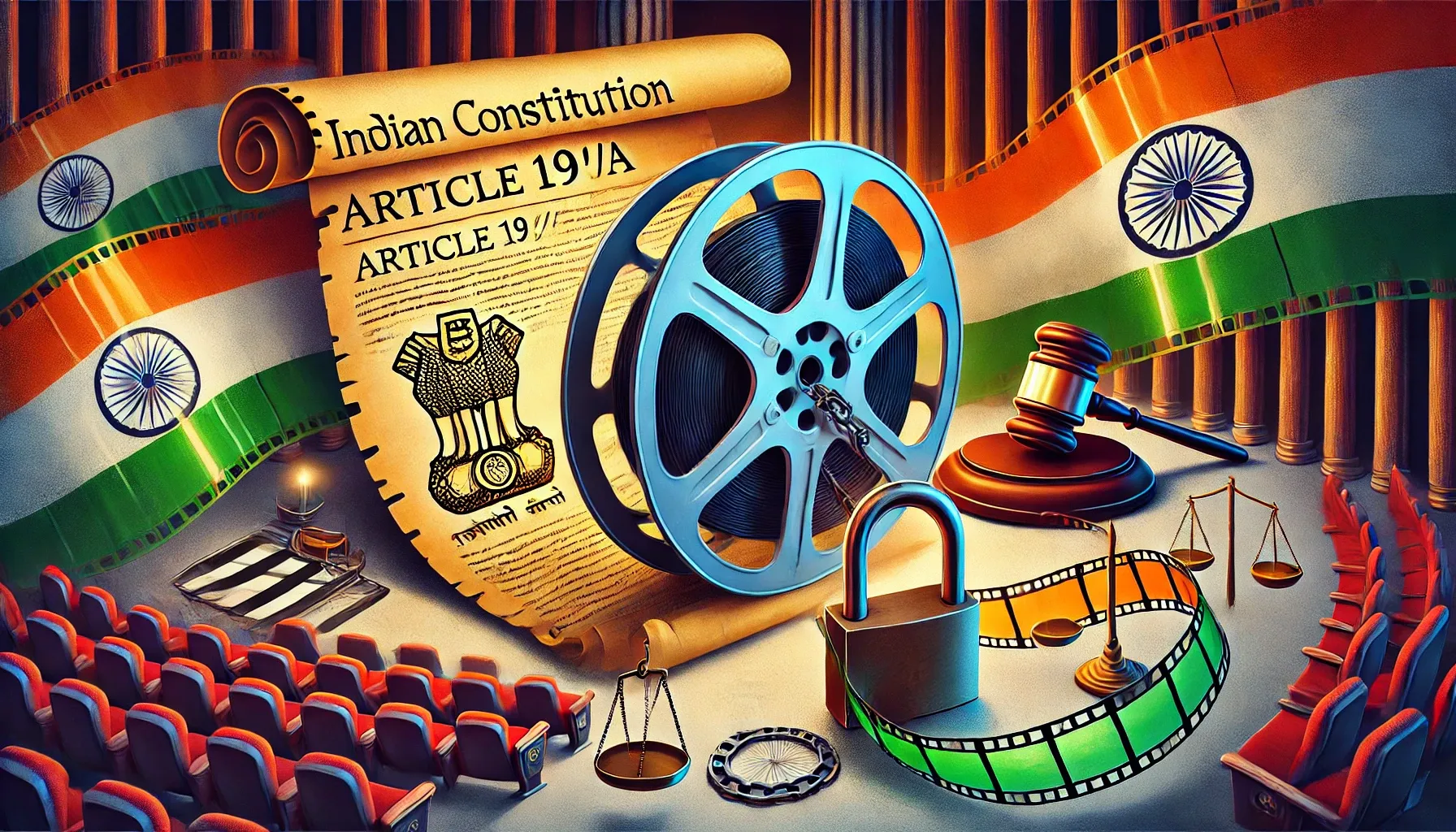Film censorship in India seeks to balance artistic freedom with societal norms. While the Constitution guarantees freedom of speech, it allows restrictions in the interest of public order, decency, and morality, with the CBFC acting as a regulatory body for this purpose.

Introduction
Censorship has been a subject of enduring debate, tracing its origins to the earliest forms of visual storytelling. Broadly defined, censorship is the act of imposing restrictions on the public expression of ideas, opinions, and conceptions to align societal discourse with accepted norms and values. The primary objective is to regulate content that may disrupt social order, incite violence, or propagate harmful ideologies. Governments worldwide, including India, exercise censorship across various media platforms to maintain societal harmony and uphold public morals.
Freedom of Speech and Law of Censorship
- In the Indian context, the freedom of speech and expression is enshrined as a fundamental right under Article 19(1)(a) of the Constitution[1]. This right, however, is not absolute.
- Article 19(2)[2] empowers the state to impose reasonable restrictions on speech and expression in the interest of public policy, morality, decency, sovereignty, and public order, among others.
- Within this constitutional framework, films, as a potent medium of expression, are subject to regulatory oversight by the Central Board of Film Certification (CBFC), a statutory body constituted under the Cinematograph Act, 1952.
- The CBFC serves as a gatekeeper for public film exhibitions, ensuring that cinematic content adheres to established societal and constitutional guidelines.
- While the Cinematograph Act provides a structured framework for regulating films, it also opens a critical space for balancing creative freedom with social responsibility. As cinema explores increasingly complex and controversial themes, the boundaries between expression and restriction continue to be tested, particularly in an era of rapid technological advancements that amplify the potential reach of harmful or divisive content.
- The doctrine of the rule of law underpins the legitimacy of censorship, asserting that all administrative actions must comply with due process as established by law.
- Censorship in India operates within this principle, tethering its validity to the reasonable restrictions prescribed under Article 19(2)[3]. However, this dynamic interplay between freedom and restriction has raised concerns over the clarity of legal provisions and the risk of arbitrary application.
- The CBFC, as established under Section 3[4] of the Cinematograph Act, comprises a Chairman and other members appointed by the Central Government. Tasked with reviewing pre-released films, the Board evaluates their suitability for public exhibition, operating as both a regulator and a mediator between filmmakers and societal expectations. Yet, its functioning often draws criticism for perceived overreach, political interference, and a lack of transparency in decision-making.
Objectives of Film Certification
Section 5B (2)[5] lays down the principles to be followed by the CBFC while sanctioning films. The guidelines require the CBFC to ensure that:
- the medium of film conforms to the values of the society.
- creative freedom or artistic expression shall not be unreasonably curbed.
- the certification must be responsive to social change.
- the film must provide clean and healthy entertainment.
- the film must be cinematically of a decent standard and is of aesthetic value.
- The CBFC must judge the film in its entirety and not from a one-track biased perspective.
CBFC: The Regulatory Authority in India and its Role
- The Central Board of Film Certification (CBFC) serves as the primary regulatory authority for film censorship and certification in India, playing a crucial role in balancing creative expression with societal norms and legal mandates.
- Established under the Cinematograph Act, 1952, the CBFC was initially called the Central Board of Film Censorship. Following subsequent amendments, its name was changed to reflect its evolving function as a certifying body. The CBFC's mandate includes certifying films for public exhibition, ensuring that the content aligns with societal values and cultural sensitivities, and providing a mechanism for redressal in cases of disputes.
- The certification process under the CBFC is governed by the Cinematograph (Certification) Rules, 1983, which outline a detailed procedure for evaluating films.
- The process begins with the Examining Committee (EC), whose members, selected by the CBFC’s Regional Officer, review the film for compliance with the Board’s guidelines. Depending on the content and target audience, films are classified into categories:
- U Certificate: For unrestricted public exhibition.
- A Certificate: Restricted to adult viewers (18+).
- S Certificate: Limited to specific professional groups or classes of individuals.
- U/A Certificate: Initially cautioning parental discretion for children under 12, this category was recently expanded through the Cinematograph (Amendment) Bill, 2023, into graded subcategories of U/A 7+, U/A 13+, and U/A 16+ to align with contemporary global standards and the IT Rules, 2021.
- Filmmakers dissatisfied with the EC’s decisions may appeal to the Reviewing Committee (RC), comprising five members who re-evaluate the film. If unresolved, further disputes may be escalated to the Film Certification Appellate Tribunal (FCAT), and ultimately, the judiciary if necessary.
- The CBFC's powers have been repeatedly scrutinized by courts, which have issued rulings to delineate its authority and protect filmmakers’ rights. In the landmark case of Bobby Art International v. Om Pal Singh Hoon[6], concerning the depiction of rape in Bandit Queen, the Supreme Court emphasized that CBFC officials must be attuned to evolving societal norms and interpret “decency” and “morality” within this dynamic framework. Such rulings highlight the delicate balance the CBFC must maintain between artistic freedom and public decency.
- Historically, the CBFC's decisions have often been influenced by governmental interference, raising questions about its independence.
- A fascinating example of this is the movie, ‘Kissa Kursi Ka’, which was published during the worst of the emergency period for free speech and expression. Since the film shows malpractice, corruption, and other like topics, the censor refuses to give it a certificate. After the change of government then, only the film was released. This demonstrates that the government stopped people from exercising their fundamental rights. This context can be relatable in today`s time where the interference of government in the decision making of the board. It is evident that every person has a right to criticise the government and express it in the form of a movie.
- Beyond censorship, the CBFC engages in consultative roles to align its operations with evolving societal contexts. It organizes symposia and seminars involving industry stakeholders, writers, and community leaders to refine its certification framework. Additionally, it conducts surveys to gauge public opinion on the impact of different film genres on societal norms, enabling adaptive guideline revisions.
- Through its multifaceted functions, the CBFC aims to strike a balance between safeguarding artistic freedoms and protecting societal values. However, its dual role as a regulatory and consultative body remains a subject of debate, reflecting the ongoing challenge of reconciling creative expression with cultural and legal expectations in a diverse society like India.
Constitutionality of Censorship
- The constitutionality of censorship in India has been a focal point of judicial interpretation, particularly concerning its alignment with Article 19(1)(a)[7] of the Constitution, which guarantees the right to freedom of speech and expression. In the landmark case of K.A. Abbas v. Union of India[8], the Supreme Court upheld the practice of film censorship, reasoning that films possess a unique power to evoke strong emotions, significantly more than other forms of art or expression. The Court acknowledged that motion pictures have a profound ability to influence public sentiment and therefore must be subject to restrictions as per Article 19(2)[9], which allows reasonable limitations in the interest of public order, decency, morality, and other concerns. Censorship, including prior restraint, was deemed a valid exercise of state power aimed at protecting societal values without necessarily violating the right to free speech.
- The case of S. Rangarajan v. P. Jagjivan Ram[10] further reinforced the constitutionality of censorship, highlighting that cinema differs from other modes of communication due to its mass appeal and profound impact on the audience. The Court observed that films, through their visual and emotional potency, can motivate actions, shape thoughts, and arouse strong feelings. Given their ability to cater to a wide and often non-selective audience, cinema cannot be allowed to function entirely unregulated, unlike newspapers or magazines. The Court concluded that censorship, including prior restraint, is not only desirable but essential to prevent the misuse of the medium in ways that could harm public peace and societal norms.
- Both rulings underscore that censorship in India, particularly of films, is a constitutionally valid mechanism designed to balance individual freedoms with collective societal interests. The judiciary has consistently held that while cinema enjoys the right to freedom of expression under Article 19(1)(a)[11], this right is not absolute and must coexist with the state’s responsibility to safeguard public morality, decency, and order. Thus, censorship, when exercised within the bounds of Article 19(2)[12] and the statutory framework, aligns with the constitutional doctrine of reasonable restrictions. These judicial pronouncements emphasize the necessity of regulatory oversight for cinema, given its unparalleled ability to influence public discourse and behaviour.
[1] The Indian Constitution, art. 19(1)(a).
[2] Id. at art. 19(2).
[3] Ibid.
[4] The Cinematograph Act, 1952, s. 3.
[5] Id. at s. 5B (2).
[6] AIR 1996 SC 1846.
[7] Supra at 1.
[8] AIR 1971 SC 481.
[9] Supra at 2.
[10] 1989 SCR (2) 204.
[11] Supra at 1.
[12] Supra at 2.


